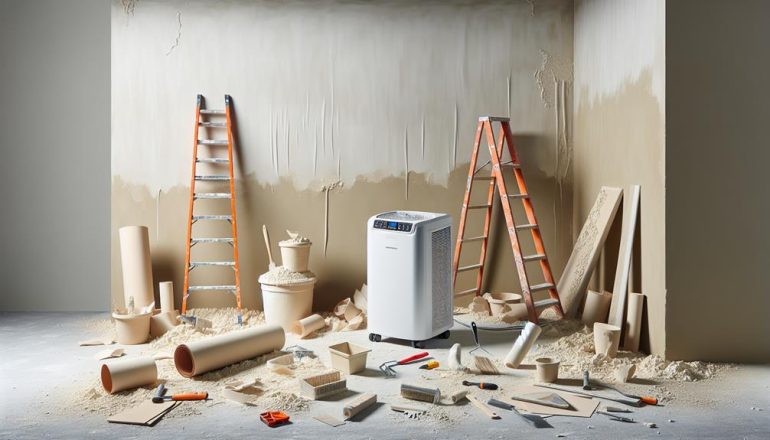Ever found yourself waiting for the plaster to dry? It’s not the most thrilling task, is it? Of course, again, the dehumidifier is of great use to us.
This humble appliance can significantly reduce the plaster’s drying time by managing the room’s humidity. However, before you power up your dehumidifier, let’s wait for a moment.
Over-dehumidifying can backfire with an act of revenge, fast-tracking the drying process of your plaster to the point of spawning an array of hairline fractures and an unwelcome fragility in the long run. Your plaster thrives in the sweet spot of 60-70% humidity, ensuring a balanced, even drying while remaining sufficiently hydrated. Put simply, it’s about maintaining the perfect hydration harmony while your newly plastered morphs into its final form, functional and aesthetically pleasing.
A Comparative Analysis: Dehumidifiers Versus Natural Drying for Plaster

In the grand scheme of plaster-drying strategies, you’ll find two prime aspirants wrestling for supremacy – the tech-forward dehumidifier method, and the classic route of natural drying.
An appliance seemingly plucked straight from a plasterer’s dreams, arms itself with the ability to gun down water vapour in the air around your newly plastered internal walls more efficiently.
By strategically absorbing water out of the air, this stellar device helps ensure that your plaster can dry without running the risk of causing the plaster to succumb to damp patches or inadvertently lead to dampness. However, keep an eye on your heating system; using a dehumidifier in conjunction with a radiator or heater can speed up the process but may take as much caution to prevent your plaster from drying too quickly.
Natural drying, on the other hand, takes a more laid-back approach. Rather than a speedy resolution, this method might take longer, yet it offers something its tech counterpart may struggle to match – a minimalist, fuss-free experience that tends to let nature run its course.
Increasing airflow becomes the primary strategy here, often managed by simply opening the windows to allow moist air to escape. Strategic use of central heating can also contribute to gently escalating the drying cycle; remember, it depends on several factors including the ambient temperature and humidity.
Although this age-old technique may lack the efficiency of an appliance, it certainly offers a slower, more controlled drying procedure, reducing the risk of potential plaster damage due to rapid drying. The verdict? Both methods serve their purpose – it’s about picking what suits you and your plasterer.
How to Speed Up Plaster Drying Time With a Dehumidifier

Harnessing the power of this device you precisely manage room moisture, it acts as a shield, securing the gypsum from the detrimental effects of excess wetness, all the while deterring the growth of mould.
To sweeten the drying method, you can use the device in combination with other methods like fans and open windows. This will help circulate the air and facilitate quicker evaporation of moisture from the lime wash.
However, it’s required to use it in moderation, as overuse could trigger over-drying, potentially leading to cracks and irreparable damage.
Why Dehumidifiers are Essential Tools for Effectively Drying Plaster
In the approach of plaster dewatering operation, a dehumidifier emerges as an outstanding mate, proficiently managing moisture levels and turbocharging the drying timeline, thus enabling a swifter project conclusion. It is, in essence, your ace in the hole for effective plaster desiccation.
- Augments Efficiency: Unleashing the device on fresh mortar catalyses the drying timeline, thus rewarding you with the invaluable gift of time.
- Regulates Humidity: This handy tool deftly curates an ideal wetness equilibrium conducive to apt mortar drying.
- Wards off Damage: The dehumidifier stands as a bulwark against any damage inflicted by excessive moisture, keeping threats like mould at bay.
- Bolsters Durability: By exercising control over the drying time, a dehumidifier supports the cause of wall finish longevity and robustness.
Dehumidifier Efficiency: Key Factors for Drying Plaster

Boosting the effectiveness of your device in the plaster desiccation process requires the strategic assessment of several critical elements. These include the quantity of plaster layers, the dampness in the room, and the ambient temperature.
- Quantity of Plaster Layers: A higher count of plaster layers lengthens the drying timeframe.
- Ambient Moistures Levels: Elevated humidity extends the drying duration. The appliance turns the tide by efficiently extracting moisture from the environment.
- Room Temperature: A warmer room can expedite the plaster desiccation process, but don’t overheat the space.
- Balanced Use: Striking a balance is essential. Do not rush the drying procedure
Utilising a dehumidifier effectively can significantly reduce the mastic drying period by consistently eliminating atmospheric moisture.
Dehumidifier Efficiency In a New Plaster Room
Harnessing the power of a dehumidifier in a fresh plaster room effectively regulates humidity levels, accelerating the plaster’s moisture removal process while warding off potential mould infestations. This keen device operates by extracting airborne water, curbing surplus moisture that could obstruct efficient drying without inflicting any harm.
The duration for the plaster to thoroughly dry spans from a mere few days to a full week, depending on the room’s environmental conditions and the plaster’s depth. Bear in mind, that overzealous dehumidifying could result in unsightly fissures and fragility, hence the emphasis on striking a balance.
Monitoring a freshly plastered chamber demands diligence to optimise the appliance’s performance, thereby fostering a cosy, mould-free environment without compromising the plaster’s robustness.
Dehumidifiers for DIY Fans: Tips for Drying Plaster at Home

For all you DIY aficionados out there, taming the wild beast that is wet plaster can often feel like balancing a unicycle on a tightrope. When it comes to drying plasterwork at home, particularly within newly plastered walls, caution is your best friend and haste is your mortal enemy.
Should your plaster dry too quickly, you’re likely to witness an unfortunate mosaic of cracks scattered across your once-perfect surface. During the drying process, it’s essential to maintain good balance; taking out excess moisture from the air reduces the risk of condensation and damp problems, yet the introduction of dry air too abruptly could damage the plaster.
Understanding the ins and outs of your specific type of plaster—be it lime plaster or gypsum plaster—can make all the difference. Layers of plaster can take anywhere from a couple of days to dry fully, with drying time depending significantly on several factors like heat sources, ventilation, and the overall moisture of your whole house. A handy tip? Keep windows and doors open to allow air to circulate and encourage a natural drying process.
At the same time, be sure to dehumidify, opening windows slightly if it’s exceptionally humid, and place a dehumidifier in a room where the plaster is damp. However, don’t rush to paint the walls until the plaster shifts from pale pink to completely dry and ready for a mist coat. Monitor the moisture levels, and let the plaster dry naturally to avoid damp issues and to ensure that the plaster is drying evenly.

